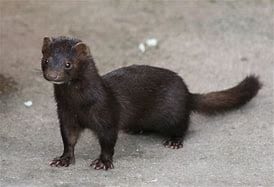I recently had a conversation about a mink sighting along the shoreline. Since this was not the first time the subject of a mink family living at the lake was brought up, and I know next to nothing about mink, I thought I should do some research.

There are two species of mink: European and American. They were once classified in the same genus, Mustela, but recent research has led to the American mink being classified separately in the Neovison genus. (IUCN) You can tell the difference between the two by their markings. While the rest of their coats are typically uniformly brown, European mink have a white patch on their upper lips – a mink mustache!
The American mink:
- Native to North America (considered invasive in Europe)
- Semi-aquatic
- Carnivorous – eats rodents, fish, crustaceans, frogs and birds. Leftovers from a kill are often kept in the mink’s den for later.
- Spend most of their time alone, except during mating season
- Have anal glands that can secrete a foul-scented fluid to ward off predators and mark an area as their own territory
Mink are found near bodies of water, such as streams, lakes or ponds that have nearby tree cover so it makes sense that they can be found at Lake Maxinkuckee. Mink will dig their own dens but their preference is to occupy those that are ready-made. You can find a mink den in an abandoned beaver dam, holes located along river and stream banks, hollow logs, muskrat burrows, rock piles, logjams, and burrows underneath tree roots.

Mink are primarily nocturnal and spend most of their activity hunting and feeding. When they find a potential meal, they bite down on the creature’s neck to kill it.
MORE FUN FACTS
- The mink’s coat is coated in oil to repel water
- Mink have webbed feet that help them swim
- Mink can swim up to 100 feet underwater
- Mink are good tree climbers
- Mink purr like a cat when they are happy
- Baby mink are called cubs or kits
- Mink can run up to 8 mph
- Mink have excellent senses of vision, smell, and hearing
Although mink look cuddly and soft, they are an animal that should not be underestimated. They are extremely violent and will attack almost anything.
Mink have few natural enemies and are not endangered. They are occasionally killed by coyotes and other carnivores but their main threat remains humans. This is due to habitat loss and trapping, however, wild mink pelts are worth far less than farmed mink. Wild pelts are currently valued between $5 – $10 each.
Farmed mink is the single most important fur type produced in North America, in terms of the number of pelts produced and the value of the fur.
But since they are still trapped, the location of this mink family is safe with me.

Hi, I’m Debbie Palmer. I received a BS in Horticulture from Purdue University. Here at LMEF, I am responsible for outreach presentations, monitoring the lake and it’s wetlands, project manager for restoration and research projects, and act as a community resource for all things related to the well-being of Lake Maxinkuckee and its surrounding watershed. I completed Indiana Watershed Leadership Academy, volunteer with the Indiana Clean Lakes Program, Hoosier River Watch and Marshall County Lakes and Waters and serve as a Board Member for Indiana Lakes Management Society.



Is that your video???!
Thank you for this email. I’ve been watching the momma and her kits this summer and have a video of them that a neighbor filmed. We do so much to screw up the lake. Fertilizers, powerful boat engines, litter along the shoreline, etc…
I’m pleased to see circle of life happening on the lake!
I’ve seen mink just a couple times in all my 50 plus years walking around the lake. Always so cool to see them. Thanks for this great article!
I thought they were mink when I saw the first picture. We have muskrat in our pond and they are fun to watch.
We just spotted a lone mink running along our sea wall – I remembered this article and was grateful to have it as a reference to share with my mom, who spotted it!